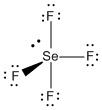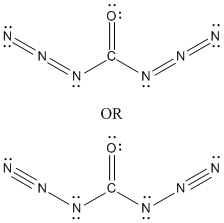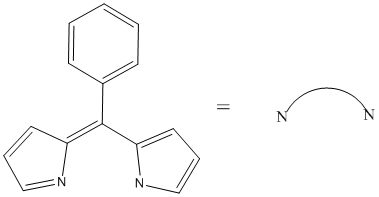Chemistry 401
Intermediate Inorganic Chemistry
University of Rhode Island
Fall 2012
Final Exam
All references are to volume 51 of Inorganic Chemistry (2012).
1. D. 1. McLean, Moody, Waterland, and Telfer (pages 446 – 455) reported the first dipyrrinato complexes of Re(I), fac-[ReL(CO)3Cl]–, where the dipyrrinato ligand is shown below. Draw the structure of this complex (use the abbreviation when drawing the structure), indicate if it is expected to be stable (explain your reasoning), give the point group, and predict the spin-only magnetic moment in units of Bohr-Magnetons.
The structure of the Re complex is:
Re(I) is low valent so the EAN rule is appropriate to determine stability: Re(I) is d6, each CO contributes 2 electrons, chloride contributes 2 electrons, and each nitrogen atom on the chelating ligand contributes 2 electrons, so the electron count is 6 + 3(2) + 2 + 2(2) = 18, so the complex is expected to be stable.
The point group is Cs.
The CO ligands are strong and the N atoms on the L ligand are expected to be fairly strong (similar to bpy), so this should be a low spin complex with all spins paired, giving a magnetic moment of 0 μB.
2. Rayson, Mackie, Kennedy, and Dlugogorski (pages 2178 – 2185) studied the decomposition of nitrous acid, HNO2. The products of the decomposition are nitric oxide (NO), nitrate ion, hydrogen ion, and water. Write the balanced reaction.
The unbalanced reaction is HNO2(aq) → NO(g) + NO3–(aq) + H+(aq) + H2O(l), which is a redox reaction. To balance:
HNO2(aq) + H+(aq) + e– → NO(g) + H2O(l) [reduction]
HNO2(aq) + H2O(l) → NO3–(aq) + 3 H+(aq) + 2 e– [oxidation]
3 HNO2(aq) → 2 NO(g) + NO3–(aq) + H+(aq) + H2O(l) [net]
3. Jackson, Dixon, and Christie (pages 2472 – 2485) calculated the thermodynamic properties of a number of selenium fluorides and selenium oxyfluorides. Write the Lewis structures for SeF4 and SeOF2, predict all of the bond angles, give the formal charge for each atom, give the oxidation number for each atom, and give the point group for each structure.
SeF4
Lewis structure:

Predicted bond angles, all F-Se-F: 90°, 118°, 179°
Formal charges: Se 0; F 0
Oxidation numbers: Se +4; F –1
point group: C2v
SeOF2
Lewis structure:

Predicted bond angles:O-Se-F, 107°, F-Se-F 107°
Formal charges: Se 0; F 0; O 0
Oxidation numbers: Se +4; F –1; O –2
point group: Cs
4. Li, Gai, Li, Wang, Niu, He, and Yang (pages 3963 – 3971) synthesized a number of lanthanide fluorides, LnF3. Consider LaF3, EuF3, and DyF3 and give the ground state term symbol for the metal ion in each compound.
LaF3
La3+ is 6s05d04f0 so the term symbol is 1S
EuF3
Eu3+ is 6s05d04f6 so L = +3 + +2 + +1 + 0 + –1 + –2 = 3 and S = ½ + ½ + ½ + ½ + ½ + ½ = 3 so the term symbol is 7F
DyF3
Dy3+ is 6s05d04f9 so L = +3 + +3 + +2 + +2 + +1 + 0 + –1 + –2 + –3 = 5 and S = ½ + ½ + ½ + ½ + ½ = 5/2 so the term symbol is 6H
5. Malliakis, Yao, Wells, Jin, Skanthakumar, Choi, Balasubramanian, Soderholm, Ellis, Kanatzidis, and Ibers (pages 6153 – 6163) investigated K6Cu12U2S15, which they found to be a semiconductor. The magnetic moment for the compound was observed to be quite low. Determine the likely oxidation state of the U in this compound. Give an explanation why this compound is a semiconductor.
For K6Cu12U2S15 the oxidation number of K is expected to be +1 and the oxidation number of S is expected to be –2. Cu could be either +1 or +2 but the low magnetic moment implies that the Cu is +1 (d10), which means that the U must be +6.
If some of the Cu is in the +2 oxidation state (note that the magnetic moment is reported as low, not 0), this would mean that some of the U could be in the +5 oxidation state. In this case, there would be a small number of free charges to move around the lattice, allowing for semiconductor behavior.
6. Biswas, Patra, Maity, Ke, Adhikary, and Ghosh (pages 6687 – 6699) used mer-carbonylchlorohydridotris(triphenylphosphine)ruthenium(II) to react with 9,10-phenanthrene-quinone. Write the structure of the metal complex, give the point group, and determine the ligand field stabilization energy in terms of Dq and P.
Structure:

Point group: Cs
This is a d6 metal in a strong field so LFSE = 24Dq – 2P
7. Nolan, Amberger, Esselman, Thimmakondu, Stanton, Woods, and McMahon (pages 9846 – 9851) describe a simple synthesis of carbonyl azide OC(N3)2. Write the Lewis structure for this molecule, give the formal charges, and estimate all bond angles.
Lewis Structure:

Formal charges: C, 0; O, 0; N terminal, –1 upper structure, 0 lower structure; N central, +1; N interior, 0 upper structure, –1 lower structure.
Bond angles: N-N-N, 180°; N-N-C, ~115° (near the average of 109° and 120°); N-C-N, 118°; N-C-O, 121°
8. Lin, Chiou, Liu, Hsieh, Yu, and Liaw (pages 10092 – 10094) describe the tetranitrosylferrate(–I) anion. Predict the structure of this ion, give the point group, and determine if it is likely to be stable or not. Explain your reasoning.
Structure:
Since the Fe is formally negative, a covalent bond approach makes most sense, which suggests VSEPR for structure determination (recall that d electrons tend not to be stereochemically active).
Point group: Td
The EAN rule can be used here: Fe(–1) is d9, each NO ligand should donate 2 electrons so the electron count is 9 + 4(2) = 17, so the complex is predicted to be unstable.
9. Ali, Nuss, Kremer, and Jansen (pages 12336 – 12342) determined the structure of CsCoO2, which they considered novel because the cobalt ion occupies tetrahedral holes. Why would it be expected that the cobalt ion should reside in octahedral holes rather than tetrahedral holes? Explain your reasoning. (Hint: use LFSE as a guide.)
The cobalt ion is Co3+ in this compound, so is d6. It is unclear whether oxide ion is a strong or weak field ligand, so consider both cases to determine LFSE:
If oxide is a strong field ligand, in Oh holes LFSE = 24Dq – 2P
If oxide is a weak field ligand, in Oh holes LFSE = 4Dq
If Co3+ is in Td holes, then LFSE = 6Dqt
Since Dqt ~ 4/9Dq for the same ligand, the LFSE (in Dq units) in Td holes is ~ 24Dq/9 ~ 2.7Dq. This means that there should be more stabilzation in Oh holes no matter the field strength of the oxide ligand: 4Dq is more stable than 2.7Dq and if oxide is a strong field ligand, then the LFSE is even greater because P < 10Dq.
10. Malcolm, Sabourin, McDonald, Ferguson, and Rivard (pages 12905 – 12916) studied ammonia borane (H3NBH3) because this compound may have use for hydrogen storage applications. The problem with ammonia borane is that it readily polymerizes so the authors suggested using a Lewis acid and a Lewis base to stabilize the material. They chose to react ammonia borane with borane tetrahydrofuran and pyridine to test the hypothesis. Predict the structure of the product containing the ammonia borane fragment.
Borane is only weakly bound to tetrahydrofuran so this complex will dissociate to give BH3 as the acid to react with the ammonia borane. The predicted reaction is:
.


3Cl.gif)